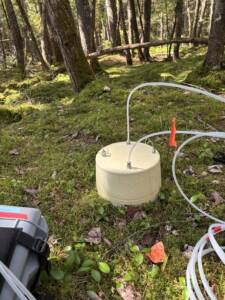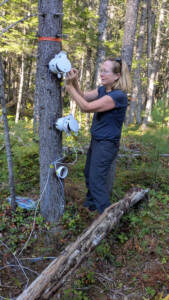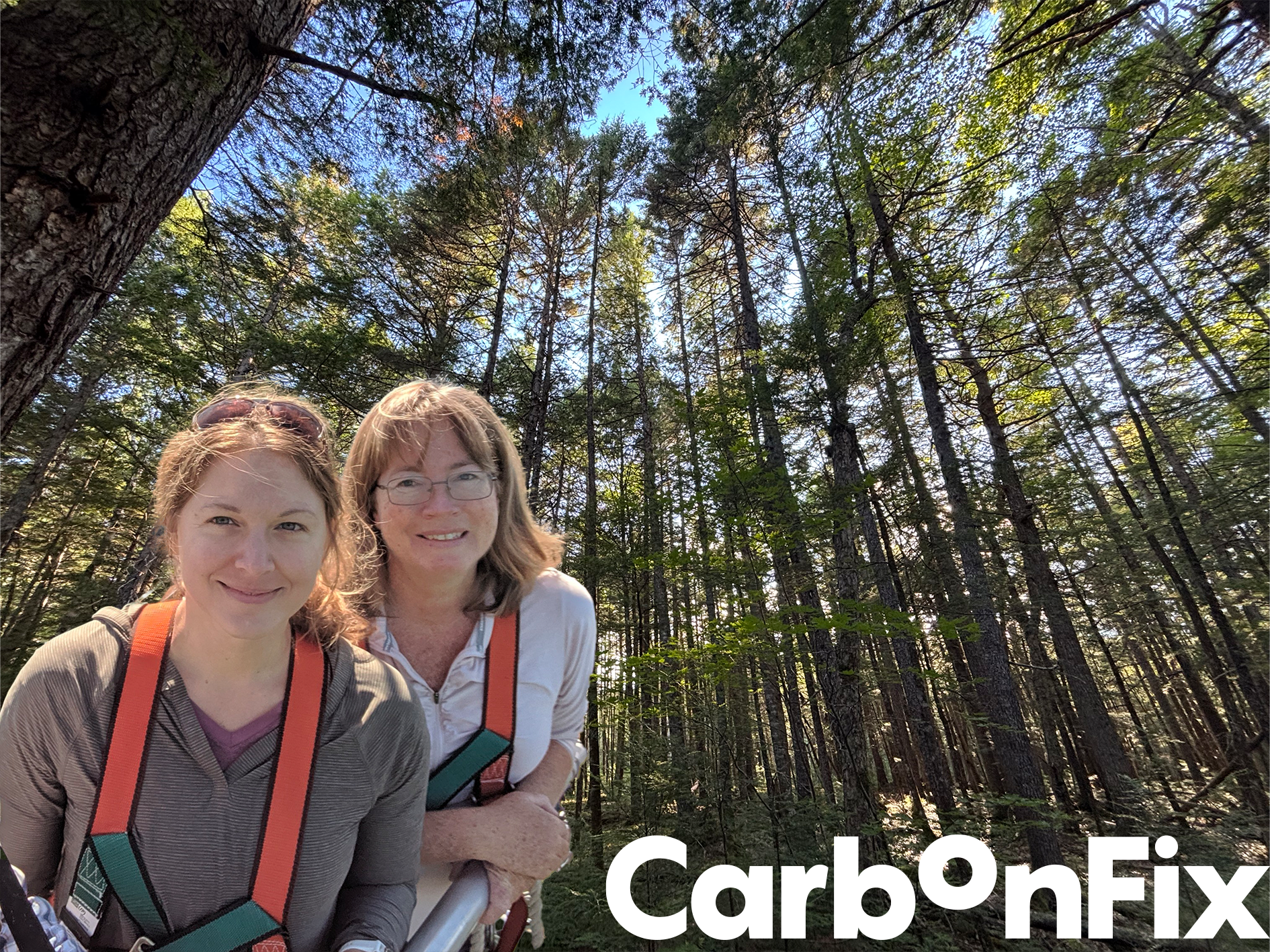The team behind Boreal Biosequester wants to harness the power of methane-consuming microbes and spread them through forests to provide scalable, cost-effective solutions to combat methane in northern regions.
Boreal Biosequester is a project from the Woodwell Climate Research Center in Massachusetts, with fieldwork carried out on the Howland Research Forest in Maine.
Dr. Jennifer Watts, the lead on the project, will spearhead data integration and synthesis, reporting and comms with stakeholders, and fundraising. Kathleen Savage will lead the forest field campaigns and technical development and testing of specialized methane flux detection chambers for the forest canopy. Hinsby Cadillo-Quiroz and his team at Arizona State University will be collecting microbial samples from the forest and identifying which methanotrophs are present at various locations on the trees. Dr. Shawn Fraver at the University of Maine Orono, which manages this site for long-term forest research, is also a collaborator.
———
When it comes to sucking carbon dioxide out of the atmosphere, trees and forests are well-known champions. But when it comes to sequestering methane, their role is much more complicated. Forest ecosystems sometimes absorb methane, other times they emit it — creating a complex exchange of gases that scientists are only beginning to understand. Boreal forests across Canada, Alaska, Scandinavia, and Russia can sometimes be methane sinks, but they’re also set to become major emitters as climate change accelerates.
That’s the challenge Boreal Biosequester is tackling. Using newly emerged technology, the team at Howland Research Forest in Maine can finally measure methane flows on a granular level to understand which bacteria consume it and how they function across the ecosystem.
Once they’ve mapped these methane-munching microbes—called methanotrophs—across varying tree species, temperatures, and seasonal shifts, the researchers want to publish their findings so governments, land trusts and foresters can enhance the activity and presence of these climate superstars, transforming ecosystems from methane sources into sinks.
CarbonFix’s grant allows Boreal BioSequester to kickstart the first year of their four-year project. The Boreal Biosequester team expect CarbonFix’s grant and support to help them secure more funding and partners to attract more funding and expand the scale of the research.
Why methane matters
Methane has been overlooked in climate discussions which largely focus on carbon dioxide, but it’s 87 times more powerful at trapping heat over a 20 year period. Atmospheric levels of methane are now 2.6 times higher than pre-industrial levels—the highest they’ve been in 800,000 years. Crucially, methane emissions from boreal forests are expected to rise or even double as temperatures rise.
Natural environments, such as wetlands and forests, account for a large portion of global methane emissions, which is why finding nature-based solutions to bring down emissions is such an important area of research. Boreal Biosequester’s approach offers the chance to turn natural sources into sinks, while also providing co-benefits such as enhanced biodiversity, wildlife habitats, flood reduction, erosion prevention, and improved air quality.
“If the methanotrophs are there, why not learn to work with them as effectively as possible?” says Jennifer. “If we were to work with human technology to reduce methane, you’d have to build something energy-intensive. This is a passive way to work with the forest sustainably. If we leave a forest to grow or regenerate, or if we afforest, we can both draw down CO2 and, we hope, consume methane.”

The genesis of the project
Jennifer and Kathleen were initially looking at methane sources and sinks for the US National Science Foundation. At first, they focused on soils, which were at the time considered the primary drivers of whether forests were sources or sinks. Then a groundbreaking paper revealed trees’ crucial role in methane uptake. With microbial ecologist Dr. Hinsby Cadillo-Quiroz from Arizona State University, they decided to study methane fluxes around tree trunks and canopies as well as in the soil, and sought funding from CarbonFix to carry out this study.
“When we looked at the canopy level, we could see net consumption, but soil data were all over the place,” Jennifer explains. “The data showed something important happening between the soils and treetops.”
The world of methanotrophs on plant surfaces is largely uncharted. The team will isolate and study these bacteria in labs while measuring methane consumption across soils, trunks, and canopies through different seasons and climates.
“We’re really the explorers venturing into this new micro-universe,” says Jennifer. “We know there are microbes out there, we just need to get to know them.”
Only in the last 15 years could methane gas be measured accurately at this scale. The team is uniquely positioned at Howland Forest, which has rare historical methane flux data from eddy covariance towers (structures measuring the exchange of gases) dating to 2011, plus access to both pristine and harvested forest areas for direct comparison.
The Method

CarbonFix’s grant will be used for the first phase to map methanotroph behavior and measuring fluxes across forest layers across the course of a year. Once they’ve secured additional funding, the team will identify optimal conditions for methane consumption across different tree species and environments. Next, they’ll test hypotheses in greenhouse settings, demonstrating how specific tree species can convert methane-emitting wetlands into methane-consuming ecosystems.
Finally, they’ll share findings through reports and presentations targeting governments, land trusts, foresters, and carbon markets to implement these practices in forest management.
Potential impact
For now, the team will focus on working out how methanotrophs function, and the conditions in which they thrive.
“A tiny creature, like a methanotroph, can influence a tree in many ways: it can fix nitrogen, it can clean metabolites. But the true beauty of this partnership is that a single tree could host methanotrophs in many ways and a thousand trees can host methanotrophs in a million ways. We just need to figure out how to channel this partnership to remove many tons of methane molecules. Achieving that would be a major breakthrough to help gain time against climate change,” says Hinsby Cadillo-Quiroz, the microbial ecologist on the project.
The findings may extend beyond forests to landfills, agriculture, logging, or fire-damaged areas — countless applications where understanding and influencing methane fluxes through bacteria could prove transformative.
What’s more, if the team’s findings show how methanotrophs can be inoculated into new forests, they could become part of every new reforestation project.
Reforestation is urgently needed: between 2001-2023, Canada, Alaska, and the Northern US lost over 70 million hectares of forest — three times the UK’s landmass — from fire and harvest. Most of these wet soil areas are net methane emitters. Reforesting and inoculating them with methanotrophs could create carbon and methane sequestration superheroes. The team estimates targeted afforestation could remove over 10 million metric tons of methane — reducing 30-40% of high-latitude methane budgets while simultaneously sequestering CO2.
But for now, there’s lots of work to be done. The team of four are rolling up their sleeves for fieldwork and lab analysis.
“At minimum, it will be fascinating data filling knowledge gaps about methane uptake,” says Kathleen. “If we can remove methane short-term, we have leeway to address more challenging CO2 elements requiring extensive work.”
Jennifer adds: “Our group is always thinking about how what we do now will impact society later. I’m excited to develop methodologies that we can share worldwide, creating community transformation for people across the planet.”




